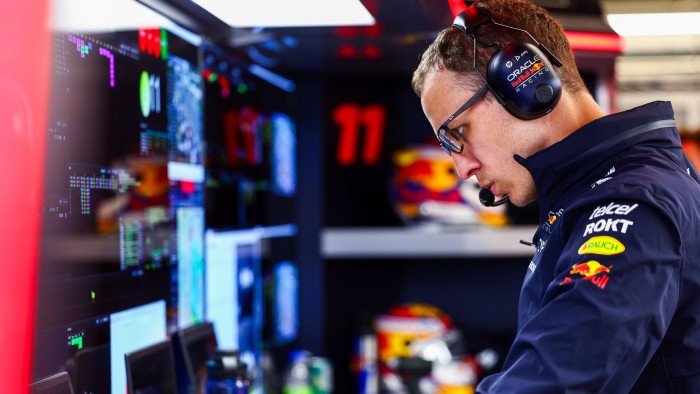Formula One is the world’s most technologically advanced sport. For more than a century, it has been an incubator of future technologies for the automotive, oil and tyre industries. So it is hardly surprising that the motorsport is now attracting companies working in artificial intelligence.
This rapidly evolving technology is set to reshape the data-intensive field of Grand Prix racing. Some engineers are predicting AI could one day take on the full design of a car, but the technology is not expected to replace the driver — autonomous car racing debuted earlier this year in a separate Abu Dhabi-funded motorsport series.
Each F1 car is fitted with 300 sensors, generating 1.1mn data points per second on the track. And the key to improving the performance of car and driver is to process that huge volume of information as quickly as possible — a task that AI makes easier.
Tanuja Randery, managing director of Amazon Web Services Europe, a partner of F1 and of Scuderia Ferrari, says the sport is the perfect environment for the new technology and has been embraced by all F1 teams. “We give them data to be able to improve their techniques and performance,” she explains. “Given the billions of data points generated here, the ability for us to do something with F1 is significant.”
James Vowles, Williams Racing team principal, who has recruited a team to work on AI and machine learning, says the technology could not have come sooner. “Data is growing exponentially, so it’s already at the point where humans can’t ingest all the data coming in from one car,” he notes.
AI has also played a prominent role in shaping F1’s technical regulations, introduced in 2022. Rules are changed every three to five years for sporting and environmental reasons and the latest set were a response to calls from fans for close racing and more overtaking.
F1’s technical department and the Fédération Internationale de l’Automobile, motorsport’s governing body, have long been able to simulate lap performance but were unable to model every aspect of racing, such as the effect of aerodynamic wake generated by a car on the one behind. So, engineers combined AI with computational fluid dynamics (CFD) to produce better simulations, resulting in a 30 per cent increase in overtaking.
AI can spot patterns in CFD simulations of specific bodywork parts. “You might do 100 different iterations of a piece to find the best one,” says Rob Smedley of Smedley Group, which consults across F1 on AI and data analysis. “But there may be something in one of those local minima that you haven’t spotted because you’re not looking for it.
“Humans instinctively look for the best piece — we’re not conditioned to look for the wrong piece that has potential,” explains Smedley, a former Ferrari and Williams F1 engineer. “AI helps teams to do that.”
The technology also helps shape race strategy: the high-pressure tactical decisions teams make on pit-stop timing and tyre selection, which can win or lose races. “It’s quite a complex game, with lots of different variables,” says Smedley. “And there can be a triggering variable, like a pit stop or a safety car, that changes the game. AI is important to govern that, to assimilate and understand.”
It is even being used to personalise the experience of F1’s 700mn global fans. AWS collaborates with software group Salesforce to tailor content to different geographies and demographics. “F1’s really trying to engage a lot more female and younger audiences, and succeeding,” says Randery of AWS. “But, to do that, you should be able to localise your content significantly.”
F1 produces TV broadcast feeds from the 24 circuits around the world and relies increasingly on AI technology in everything from shot selection for video replays to processing clips for real time social media output.
“The hardest thing about covering F1 is we have 20 cars and action happening simultaneously around a large real estate, at 200 miles an hour, unlike a stadium sport, where it’s right in front of you,” says Dean Locke, F1 director of broadcast and media. “There is a real hunger for content during the race and straight after,” he adds. “Machine learning can really help us in areas like storytelling and graphics.”
Examples of this are the recent introduction of a TV graphic that shows the time lost by a driver making a mistake in a corner, or another that forecasts when a battle between two drivers will take place.
Vowles believes AI will become core to race car design. “Do I see a car being designed, or at least bits of the car being designed with AI technology? Yes, but many, many years from now,” he says. “The one bit of it that I don’t want to see change is drivers. I’m here because we have some of the most incredible elite athletes in the world pushing themselves and the car to the limits.”
By contrast, the Abu Dhabi Autonomous Racing League, or A2RL, became the first to have AI as the performance differentiator when it held an inaugural race in April. A2RL pits programmers against each other to race driverless cars packed with sensors and actuators.
“Take the split-second decisions a human driver makes each lap to stay on the limit of grip and performance,” says Stephane Timpano, chief executive of Aspire, the UAE government agency managing A2RL. “Consider doing that through AI — where cameras, sensors, computers and actuators must navigate with speed, precision, and, most importantly, reliability.”
But Randery insists F1 will never get rid of the human factor. “AI will never drive the car,” she says. “What it will do is make the drivers just way better.”
Smedley agrees, pointing out the driver is a “major part” of F1’s appeal. “It’s always been the perfect blend of human and machine,” he says. “Technology has always assisted the driver to be a better version of himself or herself.”
Read the full article here

